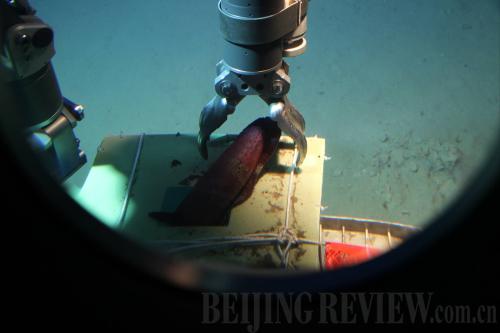|
 |
|
MAGIC HAND: Jiaolong successfully captures a sample of an abyssopelagic organism during the test in the South China Sea in July 2010 (XINHUA) |
In just 11 months, China completed a significant leap in manned dive tests from zero to 3,700 meters. The successful testing made China the fifth country in the world to possess the technology for manned dives to more than 3,500 meters below sea level, following the United States, Russia, France and Japan. The tests have also fully verified the functionality and the technical capability of Jiaolong, laying a solid foundation for practical application of scientific research and greater depth of testing—as well as resource surveys.
"For deep-sea scientific research, a manned submersible is like a car in daily traffic. Its practical significance is in enabling scientists to carry out research activities freely between 2,000 and 3,000 meters below sea level. A submersible can be seen as the lonely pioneer in deep-sea exploration," said Wang Pinxian, an academician with the Chinese Academy of Sciences and Chairman of China Marine Research Commission.
Jia Yu, a research fellow with the China Institute for Marine Affairs, said, "Deep-sea technology is considered an innovative and high-end technology as important as space and nuclear technologies."
Jiaolong's features
Different from other submersibles, Jiaolong has a unique hovering and locating ability, which enables it to adjust easily and stably to planned work. Other submersibles have to find fixed support points when starting to work. Undoubtedly, Jiaolong takes a leading position in this field.
In addition, Jiaolong also possesses advanced micro-acoustic communication and undersea topography detection capabilities, enabling high-speed transmission of images and voice and detection of small marine targets. Jiaolong is also equipped with a variety of high-performance tools enabling it to complete complex tasks such as on-the-spot sampling and core-drilling in specific marine environments and geological conditions.
Since this is China's first ultra deep-sea manned submersible project, the development team paid a great deal of attention to the safety of oceanauts. The shell of the manned submersible is made of titanium alloy, and it is equipped with foolproof life support systems and two oxygen supply systems. The designer also communicated with experts responsible for the safety systems of Shenzhou VI spacecraft several times when designing crew accommodation quarters.
Selection of oceanauts
In 2006, China began selecting its oceanauts and the requirements are as strict as those for astronauts. An oceanaut must be familiar with the structure, equipment and control of a submersible. Specific requirements include: under 35 years of age and a bachelor's degree or above in shipbuilding, machinery or electronics. In addition, they should also pass more than 100 items of physical examination.
"Hydraulic pressure 3,700 meters undersea equals 3,700 tons a square meter," said Fu Wentao, one of the oceanauts. "You will feel your body half cold, half warm in the submersible. In diving tests in the South China Sea, the temperature on the surface is up to 35 degrees centigrade while temperature in deep water is only 15 degrees centigrade. When working in the narrow control cabin of the submersible, I have to press part of my body against the bulkhead. It is cold, but the other side is very warm."
Ye Cong, the oceanaut who dived in Jiaolong to 3,759 meters on July 13, also set the record for operating a submersible underwater for 9 hours and 3 minutes. In China so far, there are only three fully qualified and licensed oceanauts, even fewer than astronauts. And among the three, only Ye has the experience of diving as deep as 3,000 meters.
Ye said an oceanaut assumes not only the tasks of captain but also driver and navigator. An oceanaut must keep a clear mind and possess a wealth of professional knowledge as well as extensive experience in marine operations. He should not only ensure the normal operations of a manned submersible in deep seas and be able to manipulate skillfully cruising and operations in the specified area, but also be responsible for navigation, communication, photography, life support, fault repair and maintenance and emergency medical treatment.
"In such a depth in the ocean, if we encounter any accident, we must deal with it immediately. If we wait for direction from the mother vessel, we could bungle the chance of remedial action," Ye said.
"We will continue to enroll more oceanauts to a total of six," said Liu Xincheng, Deputy Chief of the State Oceanic Administration's Beihai Bureau. | 